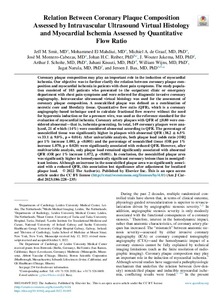Relation Between Coronary Plaque Composition Assessed by Intravascular Ultrasound Virtual Histology and Myocardial Ischemia Assessed by Quantitative Flow Ratio
Smit Jeff M.; El Mahdiui Mohammed.; de Graaf Michiel A.; Montero-Cabezas Jose M.; Reiber Johan H.C.; Jukema J.Wouter; Scholte Arthur J.; Knuuti Juhani; Wijns William; Narula Jagat; Bax Jeroen J.
https://urn.fi/URN:NBN:fi-fe202301276045
Tiivistelmä
Coronary plaque composition may play an important role in the induction of myocardial ischemia. Our objective was to further clarify the relation between coronary plaque composition and myocardial ischemia in patients with chest pain symptoms. The study population consisted of 103 patients who presented to the outpatient clinic or emergency department with chest pain symptoms and were referred for diagnostic invasive coronary angiography. Intravascular ultrasound virtual histology was used for the assessment of coronary plaque composition. A noncalcified plaque was defined as a combination of necrotic core and fibrofatty tissue. Quantitative flow ratio (QFR), which is a coronary angiography-based technique used to calculate fractional flow reserve without the need for hyperemia induction or for a pressure wire, was used as the reference standard for the evaluation of myocardial ischemia. Coronary artery plaques with QFR of ≤0.80 were considered abnormal-that is, ischemia-generating. In total, 149 coronary plaques were analyzed, 21 of which (14%) were considered abnormal according to QFR. The percentage of noncalcified tissue was significantly higher in plaques with abnormal QFR (38.2 ± 6.5% vs 33.1 ± 9.0%, p = 0.014). After univariable analysis, both plaque load (odds ratio [OR] per 1% increase 1.081, p <0.001) and the percentage of noncalcified tissue (OR per 1% increase 1.070, p = 0.020) were significantly associated with reduced QFR. However, after multivariable analysis, only plaque load remained significantly associated with abnormal QFR (OR per 1% increase 1.072, p <0.001). In conclusion, the noncalcified plaque area was significantly higher in hemodynamically significant coronary lesions than in nonsignificant lesions. Although an increase in the noncalcified plaque area was significantly associated with a reduced QFR, this association lost significance after adjustment for localized plaque load.
Kokoelmat
- Rinnakkaistallenteet [27094]
